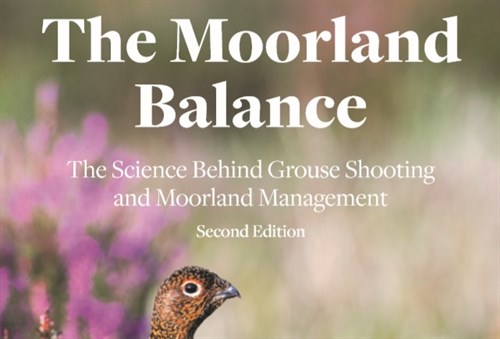Key points
- Common buzzards ate mostly small mammals and insects during the winter.
- Red grouse were only a minor prey item.
- When red grouse abundance declined, fewer red grouse were eaten.
Background
 Common buzzards are the most common raptor in Britain. In recent years their numbers have increased, and their range throughout the country has expanded. In the summer, buzzards eat red grouse, small mammals, and rabbits/hares when hunting on managed grouse moors, but there is little information on what they eat in the winter.
Common buzzards are the most common raptor in Britain. In recent years their numbers have increased, and their range throughout the country has expanded. In the summer, buzzards eat red grouse, small mammals, and rabbits/hares when hunting on managed grouse moors, but there is little information on what they eat in the winter.
Knowing what animals eat is important for many ecological studies. Understanding the diet of raptors can help assess their impact on gamebird species. Most of the existing studies looking at raptor diet were carried out during the breeding season. However, raptor diet is thought to vary between seasons, so their impact on gamebirds could occur throughout the year.
In this study, the scientists aimed to assess the winter diet of buzzards on and around Langholm Moor in southwestern Scotland.
What they did
This study took place over two winters (October-March 2013/14 and 2014/15) on Langholm Moor.
To analyse the diet of common buzzards, the scientists first located their roosting sites. They did this by watching buzzards from a viewing point and by monitoring the location of buzzards that were fitted with a radio tag or satellite transmitter. Roosting sites are areas where birds rest, and in this study the scientists were particularly interested in where the buzzards roost in winter. 44 winter roost sites were found during the two winters of this study.
Between October and March, areas near the roosts were regularly searched for pellets. A pellet is a lump of indigestible food, such as feathers and bones, that birds of prey regurgitate each day. The species of bird that produced the pellet can be worked out based on the size, shape and contents of the pellet. In this study, the scientists looked closely at the content of buzzard pellets to identify the type of prey the birds were eating. Prey was categorised as either small mammals, rabbits/hares, insects, pheasants, red grouse, and other birds. Pellets are usually regurgitated once a day, so they can contain more than one type of prey.
Each March, vole and red grouse abundance were estimated to give an idea of food availability in the area during the winter.
What they found
In this study, the scientists collected 764 buzzard pellets from winter roost sites. When these pellets were broken apart and analysed, 2,100 prey items were identified.
The most numerous type of prey was small mammals, as they made up 60-67% of all the prey items identified and were found in 88-92% of the pellets. The second most important prey group was insects. Compared to the other types of prey, red grouse made up a very small part of buzzard diet. Red grouse only made up 1.1% of prey items in 2014 and 0.6% in 2015 and were found in 3% of pellets in 2014 and 2% of pellets in 2015.
Vole abundance on Langholm Moor was the same in both winters of the study, but red grouse abundance was approximately 23% lower in the the winter of 2014 compared to 2015. The diet of buzzards varied between the two winters, with more rabbits/hares and birds being eaten in the second winter and fewer red grouse.
What does this mean?
Buzzards are opportunistic birds, which means their diet changes depending on the types of prey available in the area or at that time. In this study, the scientists found that during the winter, buzzards mainly relied on eating small mammals. Insects were also an important component of their diet, particularly earthworms and beetles, because in the winter buzzards can spend more time feeding on the soft ground. Red grouse only made up a small part of buzzard diet in this study, which suggests they are more of an incidental or opportunistic prey item.
By looking at the diet of birds of prey and other predators, the scientists can understand their impact on gamebird species. This is important to minimise conflict between people, predators and gamebirds. In this study, the scientists highlighted that red grouse were only a small component of buzzard diet during the winter on Langholm Moor.
Read the original report
Francksen R. M., Whittingham M., Ludwig S. & Baines D. (2016) Winter diet of common buzzards Buteo buteo on a Scottish grouse moor. Bird Study 63: 525-532.
About the LMDP
This study was part of the Langholm Moor Demonstration Project, a long-running collaboration between the GWCT, SNH, Buccleuch Estates, the RSPB and Natural England, which aimed to resolve the conflict between driven grouse shooting and raptor conservation. Further papers from the Langholm Moor Demonstration Project can be found on the LMDP website.

The Moorland Balance - eBook - only £4.99
Get the science behind grouse shooting and moorland management. Building on the success of the first edition, this new and improved version condenses thousands of pages of scientific literature into easy-to-read questions and answers. Over 200 different studies from across the scientific community are referenced in this 134-page book.
View Book >
or
Buy Now - £4.99 >
100% Secure. All Credit & Debit cards, PayPal, Apple Pay and Google Pay accepted.
